
Wetzlar is a city in the state of Hesse, Germany. It is the twelfth largest city in Hesse with currently 55,371 inhabitants at the beginning of 2019. As an important cultural, industrial and commercial center, the university town is one of the ten regional centers in the state of Hesse. A former free imperial city, it gained much of its fame as the seat of the Imperial Supreme Court (Reichskammergericht) of the Holy Roman Empire. Located 51 kilometers north of Frankfurt, at 8° 30′ E, 50° 34′ N, Wetzlar straddles the river Lahn and is on the German Timber-Frame Road, which passes mile upon mile of half-timbered houses. Historically, the city has acted as the hub of the Lahn-Dill-Kreis on the north edge of the Taunus. Tourists know the city for its ancient town and its medieval Catholic/Protestant shared cathedral of St. Mary. Notable architectural features include the Eisenmarkt and the steep gradients and tightly packed street layout of a medieval town. The building of the sandstone cathedral commenced in the 12th century in Romanesque style. In the later Middle Ages the construction continued under a master plan in Gothic style. The church was never finished—one steeple still remains uncompleted. The cathedral suffered heavy damage in the Second World War from aerial bombing, but restoration took place in the 1950s. On the outskirts of town along the river stand the ruins of several stone towers.
Lahn-Dill is a Kreis (district) in the west of Hesse, Germany. Neighboring districts are Siegen-Wittgenstein, Marburg-Biedenkopf, Gießen, Wetteraukreis, Hochtaunuskreis, Limburg-Weilburg, Westerwaldkreis.
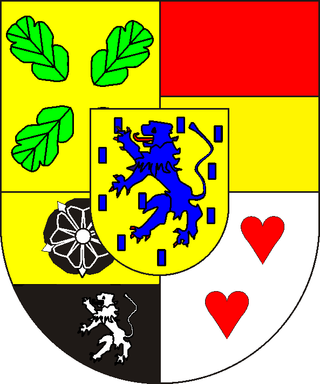
Solms-Hohensolms-Lich was at first a County and later Principality with Imperial immediacy in what is today the federal Land of Hessen, Germany. It was ruled by a branch of the House of Solms, originally from Solms.

Leun is a small town in the Lahn-Dill-Kreis in Hesse, Germany.

Aßlar is a town near Wetzlar in the Lahn-Dill-Kreis in Hesse, Germany.

Lich is a town in the district of Gießen, in Hesse, Germany. It is situated 12 km southeast of Gießen. Lich has a population of around 13,000.
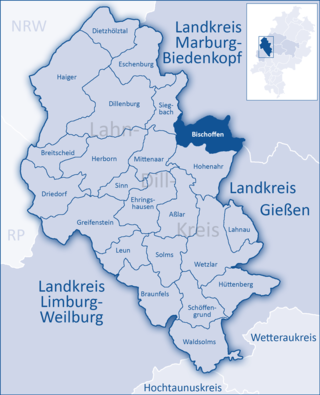
Bischoffen is a municipality in the Lahn-Dill-Kreis in Hesse, Germany.

Braunfels is a town in the Lahn-Dill-Kreis in Hesse, Germany. It is located on the German Timber-Frame Road.

Greifenstein is a municipality in the Lahn-Dill-Kreis in Hesse, Germany. Its administrative seat is Beilstein. Greifenstein covers 67.43 km² on the eastern slope of the Westerwald range. It was named for the castle of the same name in the constituent community of the same name. This is the site of the German Bell Museum, which holds about 50 bells that show the historical development of bell pouring and manufacture.
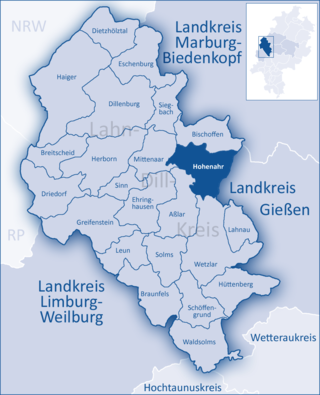
Hohenahr is a municipality in the Lahn-Dill-Kreis in Hesse, Germany.

Schöffengrund is a municipality in the Lahn-Dill-Kreis in Hesse, Germany.

Sinn is a municipality in Middle Hesse, Germany, in the Lahn-Dill-Kreis.

Waldsolms is a municipality located in the Lahn-Dill-Kreis in Hesse, Germany.
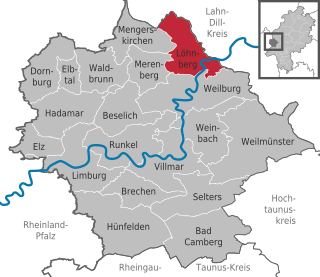
Löhnberg is a municipality north of Weilburg in Limburg-Weilburg district in Hesse, Germany.

The Altenberg is a hill in Hesse, Germany. It is next to the L3053 road.
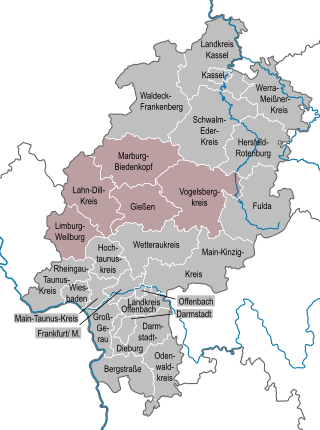
The region of Middle Hesse is one of three planning regions in the German state of Hesse, alongside North and South Hesse. Its territory is identical with that of the administrative province of Gießen and covers the counties of Limburg-Weilburg, Lahn-Dill-Kreis, Gießen, Marburg-Biedenkopf and Vogelsbergkreis. The Middle Hesse Regional Assembly, which decides on the regional plan, currently consists of 31 members chosen by the five counties and the three towns with special status: Gießen, Marburg and Wetzlar. The regional assembly has tasked the governing president (Regierungspräsident) with delivering regional management. The Mid-Hesse Regional Management Association was founded on 22 January 2003.

Albshausen is a station in the north of the district of Albshausen in the town of Solms in the German state of Hesse. The station is located on the Lahn Valley Railway (Lahntalbahn) and only a few metres from the Lahn river. Previously, the Solmsbach Valley Railway (Solmsbachtalbahn) branched off to Gravenwiesbach.
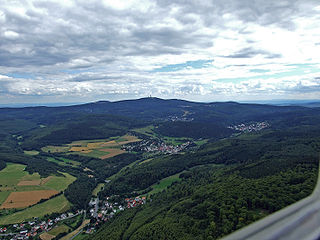
The Taunus Nature Park is a nature park in Central Germany with an area of 134,775 hectares (1347.75 km2) in the Central Upland range of the Taunus. It is one of two Hessian nature parks in the Taunus and the second largest nature park in Hesse.

Lichtenstein Castle is a levelled spur castle on the hill of Burgberg Lichtenstein, 315 m above sea level (NN), near the Greifenstein village of Holzhausen on the old military High Road, that ran from Frankfurt via Wetzlar to Cologne. The castle site is situated to the north of, and above, the Ulmbach Reservoir in the Hessian county of Lahn-Dill-Kreis.

Altenberg Abbey is a former Premonstratensian nunnery situated between Solms and Wetzlar, Hesse, Germany. It was founded in c. 1170 and dissolved in 1802. It had a strong connection with the House of Nassau, several of whom were nuns and abbesses, and some family members, including Otto I, Count of Nassau, were buried here; it was also a burial place for the Counts of Solms. The buildings were seriously damaged by a fire in 1952. Those that survive accommodate a meeting centre for the local deanery and since 2018 a small Protestant religious community.

































